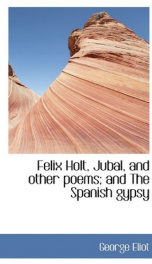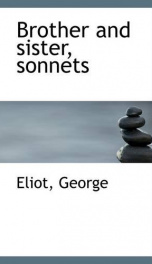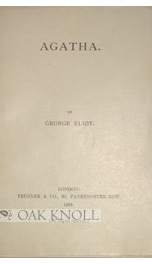Eliot George

Mary Anne (Mary Ann, Marian) Evans (22 November 1819 – 22 December 1880), better known by her pen name George Eliot, was an English novelist. She was one of the leading writers of the Victorian era. Her novels, largely set in provincial England, are well known for their realism and psychological insight. She used a male pen name, she said, to ensure that her works were taken seriously. Female authors were published under their own names, but Eliot wanted to ensure that she was not seen as merely a writer of romances. An additional factor may have been a desire to shield her private life from public scrutiny and to prevent scandals attending her relationship with the married George Henry Lewes.[1] Mary Anne Evans was the third child of Robert Evans (1773-1849) and Christiana Evans (née Pearson), the daughter of a local farmer, (1788-1836). When born, Mary Anne, sometimes shortened to Marian,[2] had two teenage siblings, a half-brother, Robert (1802-1864), and sister, Fanny (1805-1882), from her father's previous marriage to Harriet Poynton (?1780-1809). Robert Evans was the manager of the Arbury Hall Estate for the Newdigate family in Warwickshire, and Mary Anne was born on the estate at South Farm. In early 1820 the family moved to a house named Griff, part way between Nuneaton and Coventry. Her full siblings were Christiana, known as Chrissey (1814-1859), Isaac (1816-1890), and twin brothers who survived a few days in March 1821. The young Evans was obviously intelligent, and due to her father's important role on the estate, she was allowed access to the library of Arbury Hall, which greatly aided her education and breadth of learning. Her classical education left its mark; Christopher Stray has observed that "George Eliot's novels draw heavily on Greek literature (only one of her books can be printed correctly without the use of a Greek typeface), and her themes are often influenced by Greek tragedy".[3] Her frequent visits also allowed her to contrast the wealth in which the local landowner lived with the lives of the often much poorer people on the estate, and different lives lived in parallel would reappear in many of her works. The other important early influence in her life was religion. She was brought up within a narrow low church Anglican family, but at that time the Midlands was an area with a growing number of religious dissenters. She boarded at schools in Attleborough, Nuneaton and Coventry. At the second she was taught by the evangelical Maria Lewis—to whom her earliest surviving letters are addressed—and at the Coventry school she received instruction from Baptist sisters. In 1836 her mother died and Evans returned home to act as housekeeper, but she continued correspondence with her tutor Maria Lewis. When she was 21, her brother Isaac married and took over the family home, so Evans and her father moved to Foleshill near Coventry. The closeness to Coventry society brought new influences, most notably those of Charles and Cara Bray. Charles Bray had become rich as a ribbon manufacturer and had used his wealth in building schools and other philanthropic causes. Evans, who had been struggling with religious doubts for some time, became intimate friends with the progressive, free-thinking Brays, whose home was a haven for people who held and debated radical views. The people whom the young woman met at the Brays' house included Robert Owen, Herbert Spencer, Harriet Martineau and Ralph Waldo Emerson. Through this society, Evans was introduced to more liberal theologies, and writers such as David Strauss and Ludwig Feuerbach, who cast doubt on the veracity of Biblical stories. In fact, her first major literary work was translating into English Strauss' Life of Jesus (1846), which she completed after it had been begun by another member of the Rosehill circle. When Evans lost her religious faith, her father threatened to throw her out, although that did not happen. Instead, she respectably attended church for years and continued to keep house for him until his death in 1849. Five days after her father's funeral, she travelled to Switzerland with the Brays. She decided to stay in Geneva alone, living first on the lake at Plongeon (near the present United Nations buildings) and then at the Rue de Chanoines (now the Rue de la Pelisserie) with François and Juliet d’Albert Durade on the second floor ("one feels in a downy nest high up in a good old tree") (her stay is recorded by a plaque on the building). She read avidly and took long walks amongst a natural environment that inspired her greatly. François painted a portrait of her.[4] On her return in 1850, she moved to London with the intent of becoming a writer and calling herself Marian Evans. She stayed at the house of John Chapman, the radical publisher whom she had met at Rosehill and who had printed her translation. Chapman had recently bought the campaigning, left-wing journal The Westminster Review, and Evans became its assistant editor in 1851. Although Chapman was the named editor, it was Evans who did much of the work in running the journal, contributing many essays and reviews, until her departure in 1856. Women writers were not uncommon at the time, but Evans's role at the head of a literary enterprise was. The mere sight of an unmarried young woman mixing with the predominantly male society of London at that time was unusual, even scandalous to some. Although clearly strong-minded, she was frequently sensitive, depressed, and crippled by self-doubt. She was considered to have an ill-favoured appearance,[5] and she formed a number of embarrassing, unreciprocated emotional attachments, including that to her employer, the married Chapman, and Herbert Spencer. However, another highly inappropriate attraction would prove to be much more successful and beneficial for Evans.[neutrality disputed] The philosopher and critic George Henry Lewes met Evans in 1851, and by 1854 they had decided to live together. Lewes was married to Agnes Jervis, but they had agreed to have an open marriage, and in addition to the three children they had together, Agnes had also had several children by other men. Since Lewes was named on the birth certificate as the father of one of these children despite knowing this to be false, and was therefore considered complicit in adultery, he was not able to divorce Agnes. In July 1854 Lewes and Evans travelled to Weimar and Berlin together for the purpose of research. Before going to Germany, Evans continued her interest in theological work with a translation of Feuerbach's Essence of Christianity and while abroad she wrote essays and worked on her translation of Baruch Spinoza's Ethics, which she completed in 1856, but which was not published in her life-time.[6] The trip to Germany also served as a honeymoon as Evans and Lewes now considered themselves married, with Evans calling herself Marian Evans Lewes, and referring to Lewes as her husband. It was not unusual for men and women in Victorian society to have affairs; Charles Bray, John Chapman, Charles Dickens, Friedrich Engels and Wilkie Collins all had affairs with women they were not married to, though more discreetly than Lewes and Evans. What was scandalous was the Leweses' open admission of the relationship. On their return to England, they lived apart from the literary society of London, both shunning and being shunned in equal measure. While continuing to contribute pieces to the Westminster Review, Evans had resolved to become a novelist, and she set out a manifesto for herself in one of her last essays for the Review: Silly Novels by Lady Novelists. The essay criticised the trivial and ridiculous plots of contemporary fiction by women. In other essays she praised the realism of novels written in Europe at the time, and an emphasis placed on realistic story-telling would become clear throughout her subsequent fiction. She also adopted a new nom-de-plume, the one for which she would become best known: George Eliot. This masculine name was chosen partly in order to distance herself from the lady writers of silly novels, but it also quietly hid the tricky subject of her marital status. In 1858 Amos Barton, the first of the Scenes of Clerical Life, was published in Blackwood's Magazine and, along with the other Scenes, was well received. Her first complete novel, published in 1859, was Adam Bede and was an instant success, but it prompted an intense interest in who this new author might be. Scenes of Clerical Life was widely believed to have been written by a country parson or perhaps the wife of a parson. With the release of the incredibly popular Adam Bede, speculation increased markedly, and there was even a pretender to the authorship, one Joseph Liggins. In the end, the real George Eliot stepped forward: Marian Evans Lewes admitted she was the author. The revelations about Eliot's private life surprised and shocked many of her admiring readers, but this apparently did not affect her popularity as a novelist. Eliot's relationship with Lewes afforded her the encouragement and stability she so badly needed to write fiction, and to ease her self-doubt, but it would be some time before they were accepted into polite society. Acceptance was finally confirmed in 1877, when they were introduced to Princess Louise, the daughter of Queen Victoria, who was an avid reader of George Eliot's novels. After the popularity of Adam Bede, she continued to write popular novels for the next fifteen years. Within a year of completing Adam Bede, she finished The Mill on the Floss, inscribing the manuscript: "To my beloved husband, George Henry Lewes, I give this MS. of my third book, written in the sixth year of our life together, at Holly Lodge, South Field, Wandsworth, and finished 21st March 1860." Her last novel was Daniel Deronda, published in 1876, whereafter she and Lewes moved to Witley, Surrey; but by this time Lewes's health was failing and he died two years later on 30 November 1878. Eliot spent the next two years editing Lewes's final work Life and Mind for publication, and she found solace with John Walter Cross, an American banker whose mother had recently died. On 16 May 1880 George Eliot courted controversy once more by marrying a man twenty years younger than herself, and again changing her name, this time to Mary Anne Cross. The legal marriage at least pleased her brother Isaac, who sent his congratulations after breaking off relations with his sister when she had begun to live with Lewes. John Cross was a rather unstable character, and apparently jumped or fell from their hotel balcony into the Grand Canal in Venice during their honeymoon. Cross survived and they returned to England. The couple moved to a new house in Chelsea but Eliot fell ill with a throat infection. This, coupled with the kidney disease she had been afflicted with for the past few years, led to her death on the 22 December 1880 at the age of 61.
do you like this author?
What readers are saying
What do you think? Write your own comment on this book!
write a commentWhat readers are saying
What do you think? Write your own comment on this author!
write a commentBook list

felix holt the radical volume 1
Series:
Unknown
Year:
Unknown
Raiting:
3/5
This Elibron Classics book is a facsimile reprint of a 1867 edition by Bernhard Tauchnitz, Leipzig. Collection of British Authors. Volume 897
Show more
add to favoritesadd In favorites
Book list

felix holt the radical volume 1
Series:
Unknown
Year:
Unknown
Raiting:
3/5
This Elibron Classics book is a facsimile reprint of a 1867 edition by Bernhard Tauchnitz, Leipzig. Collection of British Authors. Volume 897
Show more
add to favoritesadd In favorites

felix holt jubal and other poems and the spanish gypsy
Series:
Unknown
Year:
Unknown
Raiting:
4/5
Show more
add to favoritesadd In favorites

essays and reviews of george eliot not hitherto reprinted together with an intr
Series:
Unknown
Year:
Unknown
Raiting:
3/5
Show more
add to favoritesadd In favorites

commemorative biographical encyclopedia of the juniata valley comprising the c
Series:
Unknown
Year:
Unknown
Raiting:
3.5/5
Show more
add to favoritesadd In favorites

O May I Join the Choir Invisible!
Series:
Unknown
Year:
Unknown
Raiting:
3.5/5
A collection of poems by George Eliot, the pseudonym used by Mary Ann Evans. She was one of the most important writers of the Victorian era, renowned for her deep psychological insight and sophisticated character portraits. Her most famous work, Middlemarch, is a turning point in the history of the novel. Making masterful use of a counterpointed plot, Eliot presents the stories of a number of denizens of a small English town on the eve of the Reform Bill of 1832.
Show more
add to favoritesadd In favorites
What readers are saying
What do you think? Write your own comment on this author!
write a commentif you like Eliot George try:
readers also enjoyed
What readers are saying
What do you think? Write your own comment on this author!
write a commentGenre
if you like Eliot George try:
readers also enjoyed
Do you want to read a book that interests you? It’s EASY!
Create an account and send a request for reading to other users on the Webpage of the book!



